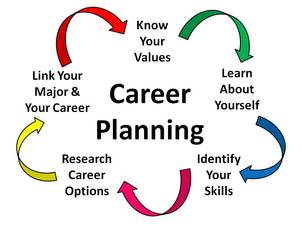
Have you thought about what you would like to do after high school?
The information and tools below can help you start planning for your future.
The information and tools below can help you start planning for your future.
Career Planning
The career planning process is comprised of four steps: Learning About Yourself, Exploring Careers, Making Decisions, and Taking Action. Choosing a career is a big deal. It's about so much more than deciding what you will do to make a living. To start with, think about the amount of time you will spend at work as an adult. Eventually, you will be working at a job approximately 71% of every year. Over your lifetime, this comes out to roughly 31 1/2 years out of the 45 years that you will spend working, from the beginning of your career until retirement. The importance of selecting a career with which you will be satisfied with cannot be overemphasized.
- Career Planning Videos: These videos are provided by CareerPlanner.com
Step 1: Learning About Yourself (Self-Assessment)
During this first step you will use a variety of tools to gather information about yourself. You will learn about your: Interests, Values, Personality Type, and Aptitudes. The more you learn about yourself the better decisions you will make about your future. The following websites provide free tests that you can take to access your interests, values, personality type, and aptitudes.
- College Foundation of North Carolina (CFNC): Check out the Learn About Yourself Page to assess your interests, values, and basic skills.
- ASVAB Military Enlistment Testing Program
- My Next Move: This site offers career interest inventory that students can take.
- Personality Testing: CareerPlanner.com offers a free personality test.
- CareerOneStop: This site offers the following assessments: Skills Profiler, Ability Profiler, Interest Profiler, Work Importance Locator, and Employability Check-Up.
Step 2: Exploring Careers
In this step you are to begin exploring the occupations that appear to be a good fit based on the results of your self assessment. It is important during this stage that you also research the industries that you are interested and the current and future trends in the labor market. If you plan to invest time and money in training or college to prepare for a particular career, you want to make sure that there will be positions available in that career field for you after completing any training or college.
Department of Education.
OOH provides information on what workers do; the work environment;
education, training, and other qualifications; pay; the job outlook; similar
occupations; and sources of additional information, for 334 occupational profiles
covering about 84 percent of the jobs in the economy.
Wage Estimates: This page will help you find the answers to the following
questions: How many people are employed in the occupation you're interested
in? Is it a fairly large field or a pretty small one?
- College Foundation of North Carolina (CFNC): Check out the Explore
- Career & Cluster Videos: These videos show the types of work people do in
Department of Education.
OOH provides information on what workers do; the work environment;
education, training, and other qualifications; pay; the job outlook; similar
occupations; and sources of additional information, for 334 occupational profiles
covering about 84 percent of the jobs in the economy.
Wage Estimates: This page will help you find the answers to the following
questions: How many people are employed in the occupation you're interested
in? Is it a fairly large field or a pretty small one?
Step 3: Making Decisions
In this step, you will decide which occupation is the best fit for you based on what you now know about yourself and the occupations you've researched. You will need consider the following:
choice.
complete and whether you will face any barriers. Barriers include family
responsibilities, financial difficulties and disabilities that may interfere with pursuing
your goals.
- Identify the occupation in which you are most interested and one or two
choice.
- Give serious thought to how you will prepare to enter your chosen career, the
complete and whether you will face any barriers. Barriers include family
responsibilities, financial difficulties and disabilities that may interfere with pursuing
your goals.
- Go back to the prior phase if you find you need to explore your options further
Step 4: Taking Action
In this step, it is time to put together a plan to reach your goals and to start moving forward. To begin, you will need to write a career plan which will help you stay on track as you pursue your career. Your career plan can be as simple or detailed as you like, but should include main sections for a specific career goal; the requirements to achieve the career goal; a list of your current skills, interests and abilities; and a realistic plan to achieve the career requirements. This stage would also include identifying and learning about potential employers, writing a resume, composing cover letters, developing a job search strategy, and preparing for a job interview.
- How to Write a Career Plan
- College of Foundation of North Carolina (CFNC): Check out CFNC's Get a Job page to get information on resume and cover letter writing and preparing for a job interview.
- Job Search Strategies
- Interview Tips for Teens Video
- How to Apply for a Job: A step by step guide to apply for a job, including how to apply for a job online, how to fill out a job application, how to write job application letters, and tips and advice for applying for jobs.
- Exploring Careers
